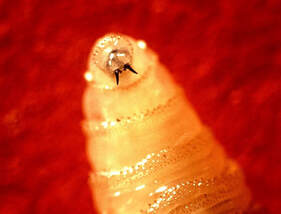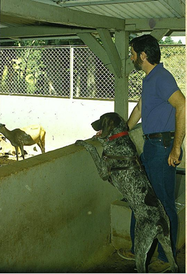 Figure 1. Screwworm larva (USDA - APHIS) Figure 1. Screwworm larva (USDA - APHIS) written by: Graham Stewart, Meghan McConnell, Tais Ribeiro On the past November 20th, Dr. John Welch, Liaison for Action Programs of International Services (APHIS) and co-recipient of the 2020 Scientist of the Year Award, brought to the Entomology colloquium his example of a successful entomological career outside of academia, sharing some of his adventures and the many roles he has occupied. Although Dr. Welch’s work has involved a variety of issues, over the years his main focus has been on eradication of the screwworm (Fig 1), Cochliomyia hominivorax (Diptera: Calliphoridae). The screwworm is a deadly, parasitic fly that feeds on the living tissues of warm-blooded animals. It has many nicknames, one being “man-eater”. It has been a problem for livestock and humans for decades, leading to major economic losses for farmers. Two entomologists Edward F. Knipling and Raymond C. Bushland, are known for pioneering successful eradication efforts through the Agriculture Research Service (ARS). They developed the sterile insect technique (SIT), a low dose of radiation to make the screwworms sterile. The flies are then raised in a lab and released in infested areas. These sterile males mate with the females and the eggs laid do not mature. Due to the success of the sterile insect technique, screwworms were eradicated in the United States in 1982. There is continued work to eradicate the screwworms in in Central and South Americas. The eradication efforts have been supported by the U.S. Department of Agriculture - Animal and Plant Health Inspection Service (USDA - APHIS). After being horrified by what these maggots can do to live animals, Dr. John Welch joined the Screwworm Eradication Program and moved to Chiapas in Mexico to work at the USDA-ARS Screwworm Research Unit. During the more than 30 years that Dr. Welch has worked for this program with USDA-ARS and later, USDA-APHIS, he has visited remote areas in ten Latin American countries to help eradicate these flies.  Figure 2. Dr. Welch and Cazador identifying screwworm infestations (Welch, personal records) Figure 2. Dr. Welch and Cazador identifying screwworm infestations (Welch, personal records) One of the highlights of the talk was the story of Cazador (hunter in Spanish), a fascinating German wire-haired pointer dog, who Dr. Welch managed to train to identify screwworm infestations. After only 5 months of training, the then three year old dog could identify infested animals, indicating this by standing up and showing interest in the animals (Fig 2). With 3 additional months of training, Cazador could also identify pupae in the ground (Welch, 1990). The dog’s skills were so impressive that, according to Dr. Welch, he became very popular among the communities where they worked and his photographs and collar are even on display at the National Agricultural Research Library! However, Dr. Welch’s job goes way beyond dog training. His usual day in the office includes intense field work, using diverse methods of transportation – from airplanes transporting sterile pupae to walking or riding horses through the farms and sites to catch fly samples and release sterile individuals (Fig 3). This also requires communication skills to interact with diverse people (and mostly in Spanish), including farmers, stakeholders, indigenous people and the general population of the villages, helping them – and being helped by them – to identify the screwworm infections. Challenges in screwworm eradication Throughout his career, Dr. Welch has faced a number of challenges on the front lines of screwworm eradication. These have often resulted in accomplishments, such as the complete eradication of screwworm in Costa Rica. One unique difficulty arose in 2003 when the radiation apparatus that sterilized screwworm flies malfunctioned, resulting in the accidental release of fertile flies in Panama. Although this was a significant setback in the screwworm eradication program in Central America, Dr. Welch and others from the USDA worked tirelessly to correct this error. Their efforts were ultimately a success as the screwworm were eliminated from areas affected by the release of sterile flies. These difficulties were not unique to his work in Central and South America. Most recently, an outbreak detected in the Florida Keys quickly became a particular cause for concern because it was potentially across many dispersed islands and one of the main targets was the Key deer, an endangered animal endemic to this region. Dr. Welch and his colleagues landed in the Keys just days after the outbreak was reported to the USDA and quickly set to work investigating cases and mapping out the spread. Most of the initial evidence in the Keys came from deer. On mainland Florida, however, it was a case of a stray dog that led the team to track down empty puparia and decide that it would be necessary to release sterile flies. In 2017, less than a year after the start of the outbreak, the screwworm had been officially eradicated. A report on this operation by Dr. Welch and his colleagues can be found in the Journal of Medical Entomology (Skoda et al. 2018). The screwworm program has been extremely successful in eradicating this parasite in several countries in Central and South America. But there is still work to be done, as the program, along with Dr. Welch and his coworkers, moves even more to the south working in Colombia, Brazil and Uruguay. This work has to be done “taking one day at a time”, as following Dr. Welch’s advice for a successful life and career, considering and caring for ourselves and others, so that we can celebrate the achievements of mitigating the effects of this deadly flesh eating worm.
Author’s Bio: Graham Stewart (@wet_naturology) is an MS student in the Palmer Lab studying wetland ecology and biogeochemistry. Meghan McConnell is a MS student in the vanEngelsdorp Lab studying honey bees. Tais Ribeiro (@taismattoso) is a PhD student in the EspindoLab, studying the ecology and evolution of the oil-collecting bees from the genus Chalepogenus. References: Skoda, S. R., P. L. Phillips, and J. B. Welch (2018). Screwworm (Diptera: Calliphoridae) in the United States: Response to and Elimination of the 2016–2017 Outbreak in Florida. Journal of Medical Entomology, 55(4), 777–786. Welch, J. B. (1990). A detector dog for screwworms (Diptera: Calliphoridae). Journal of economic entomology, 83(5), 1932-1934. Comments are closed.
|
Categories
All
Archives
June 2024
|
Department of Entomology
University of Maryland
4112 Plant Sciences Building
College Park, MD 20742-4454
USA
Telephone: 301.405.3911
Fax: 301.314.9290
University of Maryland
4112 Plant Sciences Building
College Park, MD 20742-4454
USA
Telephone: 301.405.3911
Fax: 301.314.9290


 RSS Feed
RSS Feed




